
Phragmipedium is a genus of the Orchid family (Orchidaceae) and the only genus comprised in the tribe Phragmipedieae and subtribe Phragmipediinae. The name of the genus is derived from the Greek phragma, which means "division", and pedium, which means "slipper". It is abbreviated 'Phrag' in trade journals.

Calotropis gigantea, the crown flower, is a species of Calotropis native to Cambodia, Vietnam, Bangladesh, Indonesia, Malaysia, the Philippines, Thailand, Sri Lanka, India, China, Pakistan, Nepal, and tropical Africa.

Liparis, commonly known as widelip orchids, sphinx orchids or 羊耳蒜属 is a cosmopolitan genus of more than 350 species of orchids in the family Orchidaceae. Plants in this genus are terrestrial, lithophytic or epiphytic herbs with a wide range of forms. The flowers are usually resupinate and small to medium sized, yellow, yellow-green or purplish with spreading sepals and petals. The labellum is usually larger than the sepals and petals and is lobed, sometimes with a toothed or wavy margin and one or two calli at its base.

Luisia, commonly known as velvet orchids or 钗子股属 , is a genus of epiphytic or lithophytic orchids in family Orchidaceae. Plants in this genus have flattened roots, long leafy stems, narrow, thick, leathery leaves and short-lived flowers that open sporadically. There are about forty species found from tropical and subtropical Asia to the Western Pacific.

Dendrobium nobile, commonly known as the noble dendrobium, is a member of the family Orchidaceae. It has become a popular cultivated decorative house plant, because it produces colourful blooms in winter and spring, at a time when little else is in flower. It is also one of the 50 fundamental herbs used in traditional Chinese medicine, known as shí hú or shí hú lán. Dendrobium nobile is one of the most widespread ornamental members of the orchid family. Its blooms are variegated in colour, shading from white through pink and purple, and the many different cultivated varieties produce different sized and coloured blooms.

Acampe rigida is a species of orchid native to the forests of tropical southern Asia where it grows on trees and rocks at altitudes of up to 1,800 m (6,000 ft).

Vanda cristata is a species of orchid found growing in the Himalaya from Bangladesh, India, Nepal, Bhutan to China at elevations of 600 – 2300 meters.

Papilionanthe Miss Joaquim, also known as the Singapore orchid, the Princess Aloha orchid and formerly as Vanda Miss Joaquim, is a hybrid orchid that is the national flower of Singapore. For its resilience and year-round blooming quality, it was chosen on 15 April 1981 to represent Singapore's uniqueness and hybrid culture.

Oberonia, commonly known as fairy orchids, is a genus of flowering plants in the family Orchidaceae. Orchids in this genus are epiphytic or lithophytic plants with the leaves arranged fan-like, overlapping at the base and spreading near the tips. Large numbers of tiny, short-lived, cup-shaped, non-resupinate flowers are arranged on an arching flowering stem that emerges from the base of the uppermost leaf. There are about 240 species occurring from tropical and southern Africa to the Pacific.
Epidendrum geminiflorum is a tropical epiphytic orchid native to Colombia, Ecuador, Peru, Suriname, and Venezuela at elevations of 2.3—2.9 km.

Iris kashmiriana is a plant species in the genus Iris, it is also in the subgenus Iris. It is a rhizomatous perennial, from Kashmir, India. It has straight, sword-shaped, glaucous leaves, tall, thick stem with up 2 short branches, which hold 2–3 flowers, which can be white, cream or pale blue, lilac, lavender or blue-purple. It is cultivated as an ornamental plant in temperate regions, although in Kashmir, it is also planted on graves.
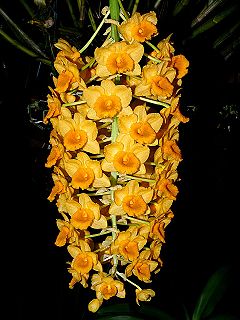
Dendrobium densiflorum is a species of epiphytic or lithophytic orchid, native to Asia. It has club-shaped stems, three or four leathery leaves and densely flowered, hanging bunches of relatively large pale yellow and golden yellow flowers.

Pelatantheria insectifera is a species of orchid occurring in Thailand, Laos, India. The species is a long-stemmed epiphytic herb. The small flowers have a relatively large, fleshy, bright pink labellum. The specific epithet "insectifera", meaning "insect bearing", refers to the flowers, which are indicated to resemble an insect. Thus, attraction of pollinators by means of sexual deception is implied, but to date no pollinator has been published. The flowers are produced from September to October on subsessile racemes, which are shorter than the leaves. The plants are almost entirely self-incompatible, but a small percentage of self-pollination events may be successful. After pollination the colour of the labellum changes from pink to red and the sepals and petals begin to close.
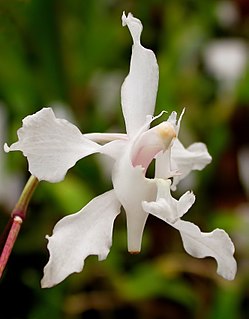
Papilionanthe vandarum is a species of epiphytic orchid native to India, China, Myanmar, and Nepal. Is is closely related to Papilionanthe biswasiana.
Papilionanthe biswasiana is a species of epiphytic orchid native to Laos, China, Myanmar, and Thailand. Is is closely related to Papilionanthe vandarum.
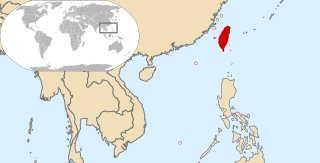
× Papilisia taiwaniana is an artificial hybrid of Papilionanthe teres and Luisia megasepala. It arose after the introduction of Papilionanthe teres to Taiwan, where it interbred with the Taiwanese endemic Luisia megasepala. It was formerly included in Papilionanthe. The occasionally branched, pendulous, terete stems are 30 to 60 cm in length and 4 to 4.5 mm wide. The terete, 14 to 21 cm long and 2 to 3.5 mm wide leaves are not strictly distichously arranged, but rather laxly alternate. Two 4–5 cm wide, yellowish flowers are produced on 2 to 3 cm long inflorescences. The labellum bears brown-red longitudinal stripes. Like its parent species, this plant grows epiphytically.
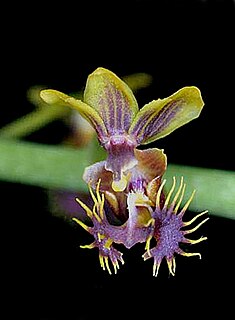
Phalaenopsis difformis, also known as the dark brown Phalaenopsis, is a species of epiphytic orchid native to Assam, Borneo, China South-Central, China Southeast, East Himalaya, Laos, Malaya, Myanmar, Bangladesh, Nepal, Sumatera, Thailand, Vietnam and West Himalaya. This species has a complex taxonomic history and has been previously assigned to several genera. The extensive list of synonyms may be explained by this species wide distribution. Within this species two variations, Phalaenopsis difformis var. difformis and Phalaenopsis difformis var. kinabaluensis Kocyan & Schuit., are formally recognized.
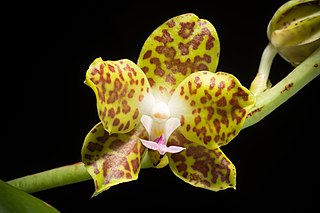
Phalaenopsis hygrochila, also known as 湿唇兰 in Chinese, is a species of epiphytic orchid native to Assam, Borneo, China South-Central, China Southeast, East Himalaya, Laos, Malaya, Myanmar, Bangladesh, Nepal, Sumatera, Thailand, Vietnam and West Himalaya. This species has a complex taxonomic history and has been previously assigned to several genera. The extensive list of synonyms may be explained by this species wide distribution, its early discovery and unusual morphology compared to other species of the genus Phalaenopsis.

Vanda dives is a species of epiphytic orchid native to Vietnam and Laos.

Phalaenopsis kapuasensis, also known as the Kapuas Hulu Phalaenopsis, is a species of orchid endemic to Borneo. The specific epithet kapuasensis refers to the indonesian locality Kapuas Hulu, from which the type specimen was obtained.


















